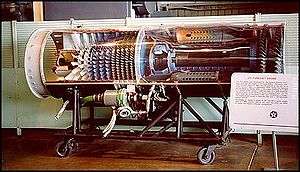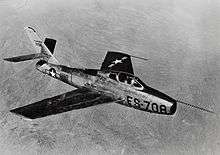General Electric J73
The General Electric J73 turbojet was developed by General Electric from the earlier J47 engine. Its original USAF designation was J47-21, but with innovative features including variable inlet guide vanes, double-shell (inner and outer) combustor case, and 50% greater airflow was redesignated J73. Its only operational use was in the North American F-86H.
| J73 | |
|---|---|
 | |
| Cutaway of a J73 at the NMUSAF | |
| Type | Turbojet |
| National origin | United States |
| Manufacturer | General Electric |
| Major applications | North American F-86H Sabre |
| Number built | 870 |
| Unit cost | $145,000 |
| Developed from | General Electric J47 |
| Developed into | General Electric J79 |
Design and development
An engine, uprated from the J47, was required for the F-86H. The mass flow was increased by relocating accessories from the centre of the compressor inlet to the underside of the engine. This allowed a reduction in blade hub diameter, which together with an increase in tip diameter, gave a bigger area for air to enter the compressor. The area through the combustion chambers also had to be increased. This was done by replacing the multiple individual chambers with a single annular casing with individual flame tubes or cans known as cannular.[1]
The pressure ratio was increased and variable inlet guide vanes fitted to prevent low-RPM problems (rotating stall/blade flutter) with the higher design pressure ratio. A 2-stage turbine was required.[2][3]
A low boost (10% at take-off) afterburner was fitted. It was known as a tailpipe augmentation (TPA) system.[3]
Variants

- J73-GE-1
- J73-GE-3
- 9,200 lbf (40.92 kN) for the North American F-86H Sabre.
- J73-GE-5
- Variant intended for a proposed Advanced F-89.[4]
Applications

- North American F-86H Sabre
- Republic YF-84J Thunderstreak, two prototypes
Specifications (J73-GE-3)
Data from Flight 9 April 1954 : Aero Engines 1954[5], Aircraft engines of the World 1953[6]
General characteristics
- Type: non-afterburning turbojet
- J73-GE-5 with afterburning
- Length: 200 in (5,080 mm)
- Diameter: 39.5 in (1,003 mm)
- Dry weight: 3,600 lb (1,630 kg)
Components
- Compressor: 12 stage, axial flow, variable inlet guide vanes
- Combustors: 10 cannular combustion chambers
- Turbine: 2 stage axial turbine
- Fuel type: MIL-F-5624A / JP-4
- Oil system: dry sump, pressure spray with gear pumps
Performance
- Maximum thrust: 9,000 lbf (40 kN)::::J73-GE-5 - 9,500 lbf (42 kN) dry, 12,500 lbf (56 kN) with afterburner
- Overall pressure ratio: 7.5:1
- Air mass flow: 155 lb/s (70 kg/s)
- Specific fuel consumption: 0.9 lb/(lbf⋅h) or 25 g/(kN⋅s)
- Thrust-to-weight ratio: 2.5
- J73-GE-5 - 2.64 dry, 3.47 with afterburner
See also
Related development
Comparable engines
Related lists
References
| Wikimedia Commons has media related to General Electric J73. |
- "Aero Engines 1957". Flight: 133. 26 July 1957.
- Johnsen, Irving A.; Bullock, Robert 0. (1965). NASA SP-36 : AERODYNAMIC DESIGN OF AXIAL-FLOW COMPRESSORS (PDF). Washington D.C.: NASA. pp. 27a, 44. Retrieved 24 February 2019.
- Seven Decades of Progress: A Heritage of Aircraft Turbine Technology. Fallbrook: Aero Publishers. 1979. p. 82. ISBN 9780816883554.
- "Standard Aircraft Characteristics: Advanced F-89" (PDF). US Air Force. 3 December 1951. Retrieved 30 December 2018.
- "Aero Engines 1954 : The World's Leading Aero-engine Constructors and their Products Reviewed". 9 April 1954: 457. Retrieved 24 February 2019. Cite journal requires
|journal=(help) - Wilkinson, Paul H. (1953). Aircraft engines of the World 1953 (11th ed.). London: Sir Isaac Pitman & Sons Ltd. pp. 82–83.
Further reading
- Gunston, Bill (2006). World Encyclopedia of Aero Engines, 5th Edition. Phoenix Mill, Gloucestershire, England, UK: Sutton Publishing Limited. ISBN 0-7509-4479-X.
- Kay, Anthony L. (2007). Turbojet History and Development 1930֪–1960 Volume 2:USSR, USA, Japan, France, Canada, Sweden, Switzerland, Italy and Hungary (1st ed.). Ramsbury: The Crowood Press. ISBN 978-1861269393.